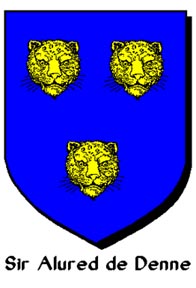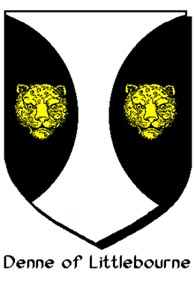|
circa 1234 The seal of Sir Alured de Denne featured three leopard
faces or three leopard heads caboshed, and the coat of arms to the right
|
 |
|
Denne of Littlebourne The Arms of Denne of Littlebourne
|
 |
Correspondence between Denne descendants Janet Denne and Wendy Walker dated 2002 suggests that the Denne name is possibly or even likely of Saxon origin, and based on a place name.
The "dennes" were the areas of land bounded by the transhumance routes in Kent in Saxon times, so the Denne name may be of Saxon origin. These "dennes" which threaded through the woodlands of the Kentish Weald in the 6th and 7th centuries were the low-lying clearings which gave free passage to the livestock between areas of pasturage. They also served as woodland pasture for swine, but that was not their primary function.
Edward the Confessor was born in 1002, son of King Æthelred the Unrede and Emma of Normandy, who was a sister of Richard (II) "the Good", 4th Duke of Normandy. Following the invasion of England and the victory in 1013 of the Danish King Sweyn Forkbeard, it was natural that King Æthelred, his wife Emma and their family sought refuge in the court of Emma's brother Richard "the Good". They certainly took retainers with them, and it is possible that a member of the Dene family was included.
However, Sweyn Forkbeard was never actually crowned King of England; and when he died on February 3, 1014, the Witan recalled Æthelred who reigned until his death on April 23, 1016. Emma, too, returned to England; and following the death of Æthelred, she married the Danish King Canute. The young Edward the Confessor, however, remained in Normandy until he was invited to return to England in 1041 by his half brother and Canute's successor, the childless King Hardecanute. Edward the Confessor was proclaimed King of England following Hardecanute's death in 1042.
In order to strengthen his hold on the crown and to prevent the Saxon earls from becoming too powerful, King Edward the Confessor gave fiefs to Norman lords. One of these Norman lords was Robert de Dene; and although it cannot be proven, it is possible that he was a descendant, perhaps a son, of a Saxon retainer who had accompanied the family of King Æthelred and Emma of Normandy into exile almost thirty years before.
|
circa 1234 The seal of Sir Alured de Denne featured three leopard
faces or three leopard heads caboshed, and the coat of arms to the right
|
 |
|
Denne of Littlebourne The Arms of Denne of Littlebourne
|
 |
Please visit the Sewell Genealogy Site Map for other pages in this series.
 |